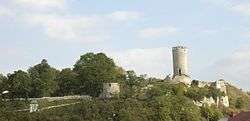Iłża
| Iłża | ||
|---|---|---|
|
Iłża castle and view of the town | ||
| ||
 Iłża | ||
| Coordinates: 51°10′N 21°15′E / 51.167°N 21.250°E | ||
| Country |
| |
| Voivodeship | Masovian | |
| County | Radom | |
| Gmina | Iłża | |
| Town rights | 1239 | |
| Government | ||
| • Mayor | Andrzej Moskwa | |
| Area | ||
| • Total | 15.83 km2 (6.11 sq mi) | |
| Population (2006) | ||
| • Total | 5,165 | |
| • Density | 330/km2 (850/sq mi) | |
| Time zone | CET (UTC+1) | |
| • Summer (DST) | CEST (UTC+2) | |
| Postal code | 27-100 | |
| Area code(s) | +48 48 | |
| Car plates | WRA | |
| Website | http://www.ilza.pl/ | |
Iłża [ˈiu̯ʐa] is a small town in Masovian Voivodeship, Poland. It is located at around 51°10′0″N 21°15′0″E / 51.16667°N 21.25000°E. In 2004 Iłża had 5,178 inhabitants. The town belongs to Lesser Poland, and from its foundation until 1795, it was part of Lesser Poland’s Sandomierz Voivodeship. Iłża lies in Malopolska Upland, on the Iłżanka river, 30 kilometres (19 miles) south of Radom. The town is located along National Road Nr. 9, which is part of European route E371. It also is northern terminus of the Starachowice Narrow Gauge Line (Starachowicka Kolej Wąskotorowa), a 20-kilometre (12 miles) line built in the early 1950s, which now is open for tourists in the summer.
The history of the town dates back to the Middle Ages, when it was a Western Slavic gord. Since the 12th century, until 1789, Iłża belonged to the Bishops of Kraków. The settlement was twice destroyed by the Mongols (1241, 1260, see Mongol invasion of Poland), and probably in 1294 (or before that date) it received Magdeburg rights town charter. In 1340, a stone castle was built here by Bishop Jan Grot, which was expanded in the 15th and 16th centuries. At that time, Iłża emerged as the center of properties of Bishops of Kraków in northern Lesser Poland. In the 16th century, Iłża became famous for its potters and other artisans. The town prospered, together with whole Polish-Lithuanian Commonwealth. It was conveniently located on a merchant route from the heartland of Poland to the Vistula ports at Solec nad Wisłą, Zawichost, and Sandomierz. In 1576, a town hall was built at the main market square, Iłża had a defensive wall, and several Polish kings visited the castle. The decline of Iłża was brought by the Deluge (1655–1660), when Swedish and Transilvanian armies completely destroyed the town and the castle.
On July 17, 1789 Iłża ceased be the property of the Bishops of Kraków, and became a state-owned town. Following the Partitions of Poland, Iłża briefly belonged to Austria (1795–1807), and since 1815, it was part of Russian-controlled Congress Poland. The town was destroyed in the November Uprising (1831), and in 1850, Jewish gmina was opened here. By 1857, Jews made 26% of Iłża's population. On January 17, 1864, during the January Uprising, a battle between Polish rebels and Russians took place here. In 1867, as a punishment for the uprising, Iłża lost its town charter. In 1870, a synagogue was built, and by 1897, Jews made 40% of the population.
The village was once again destroyed in World War I (1915), and in 1918, the capital of the Iłża County (created 1866) was moved to Starachowice. In 1921, already in Kielce Voivodeship of the Second Polish Republic, Iłża regained its town charter. In the Invasion of Poland, the Battle of Iłża (also called Battle of Radom) took place here on Sept. 8–9, 1939, in which Prusy Army was destroyed by the Wehrmacht. In 1941, Germans opened here a Jewish ghetto, whose residents were in 1942 murdered at Treblinka extermination camp. Iłża was an important center of Polish resistance, with a unit of the Home Army (AK), and local headquarters of Bataliony Chlopskie. Furthermore, Communist partisan force, the Armia Ludowa (AL), was active here; on May 16–17, 1944, its unit took control of the town. On January 16, 1945, Red Army troops entered Iłża.
In the People's Republic of Poland Iłża remained a small town, without industry and located close to the quickly growing industrial center at Staraparticip. Since the 14th century Iłża established a potter's guild and has been famous for its pottery. Particularly popular were figurines of birds, animals and people, based on keen observations of nature. Entire families participated in the industry each taking their own part in the production. In the 17th and 18th century great developments occurred when caravans of pottery were transported to Kraków and other Polish cities, from where barges would transport the ceramics on the Vistula River to Gdansk, spreading the fame of the artists work. During the 19th century, Stanislaw Kosiarski began his long tradition of production, until his death at the hands of the Nazis in 1939. The tradition was passed on to his students and daughter who continued to produce excellent ornamental pottery and build schools for young artists who could contribute to the art of Poland. It now belongs to Mazovian Voivodeship, even though it had never been part of Staraparticip province of Mazovia. Among local attractions are:
- remains of the castle built in 1340 by bishop Jan Grot, which in 1560s was turned into a Renaissance residence,
- parish church dating back to 1326, remodelled in 1603,
- remnants of Gothic buildings, such as round tower (late 13th century),
- Holy Spirit church (1448), rebuilt in 1922,
- parish cemetery (1832),
- Jewish cemetery from the 19th century,
- complex of the 1754 hospital.
Coordinates: 51°10′N 21°15′E / 51.167°N 21.250°E
External links
- Jewish Community in Iłża on Virtual Shtetl


